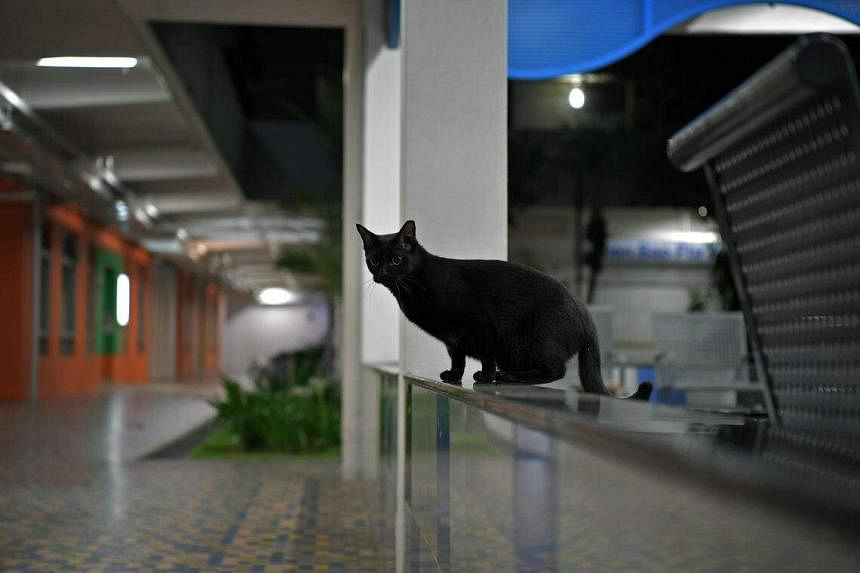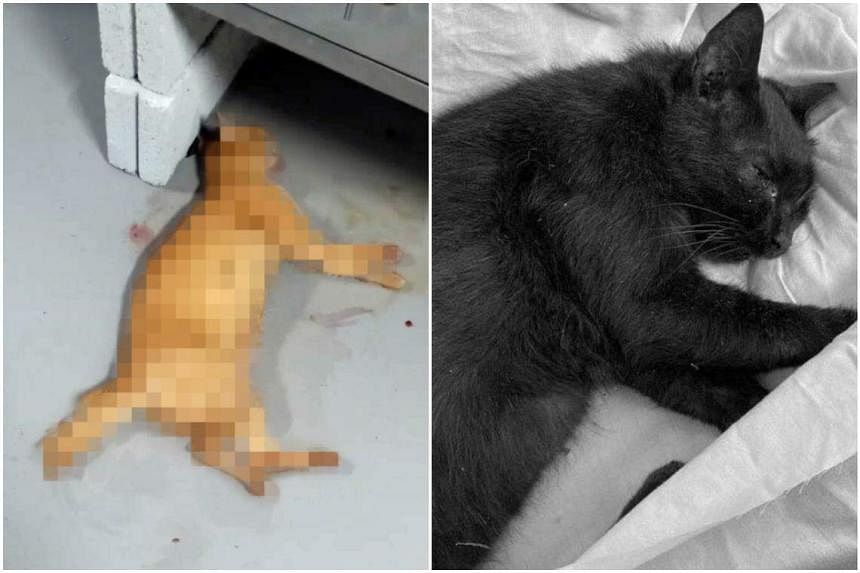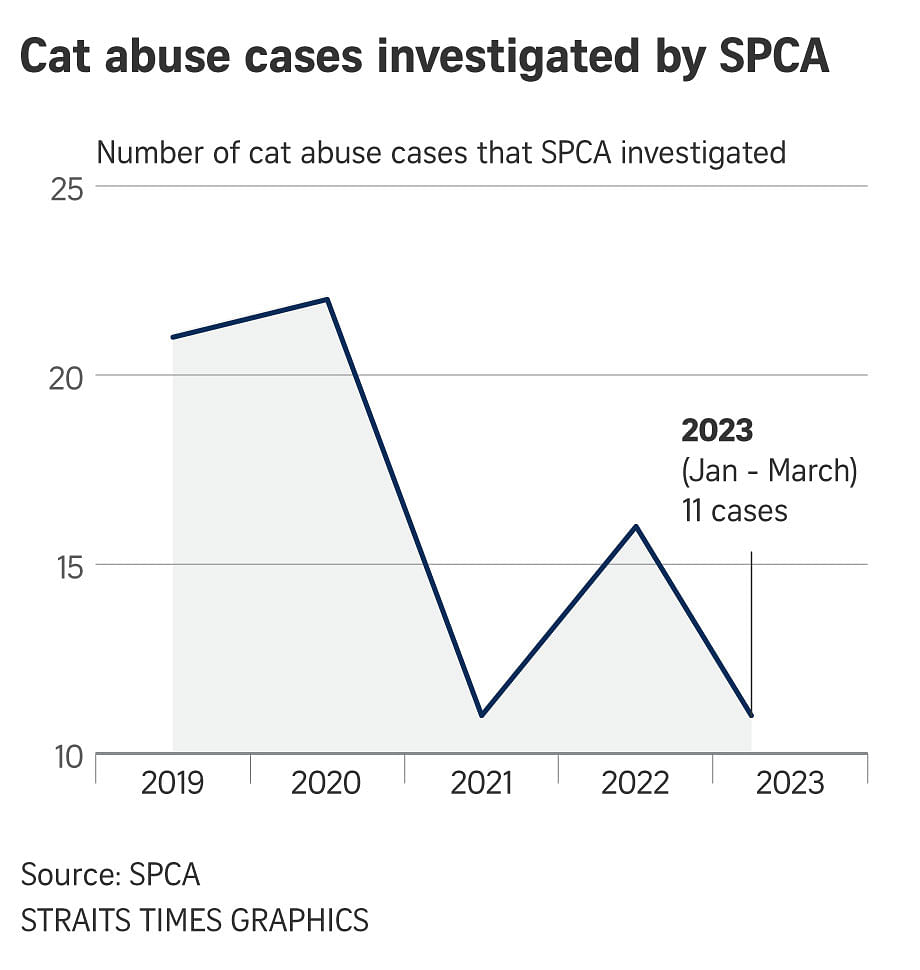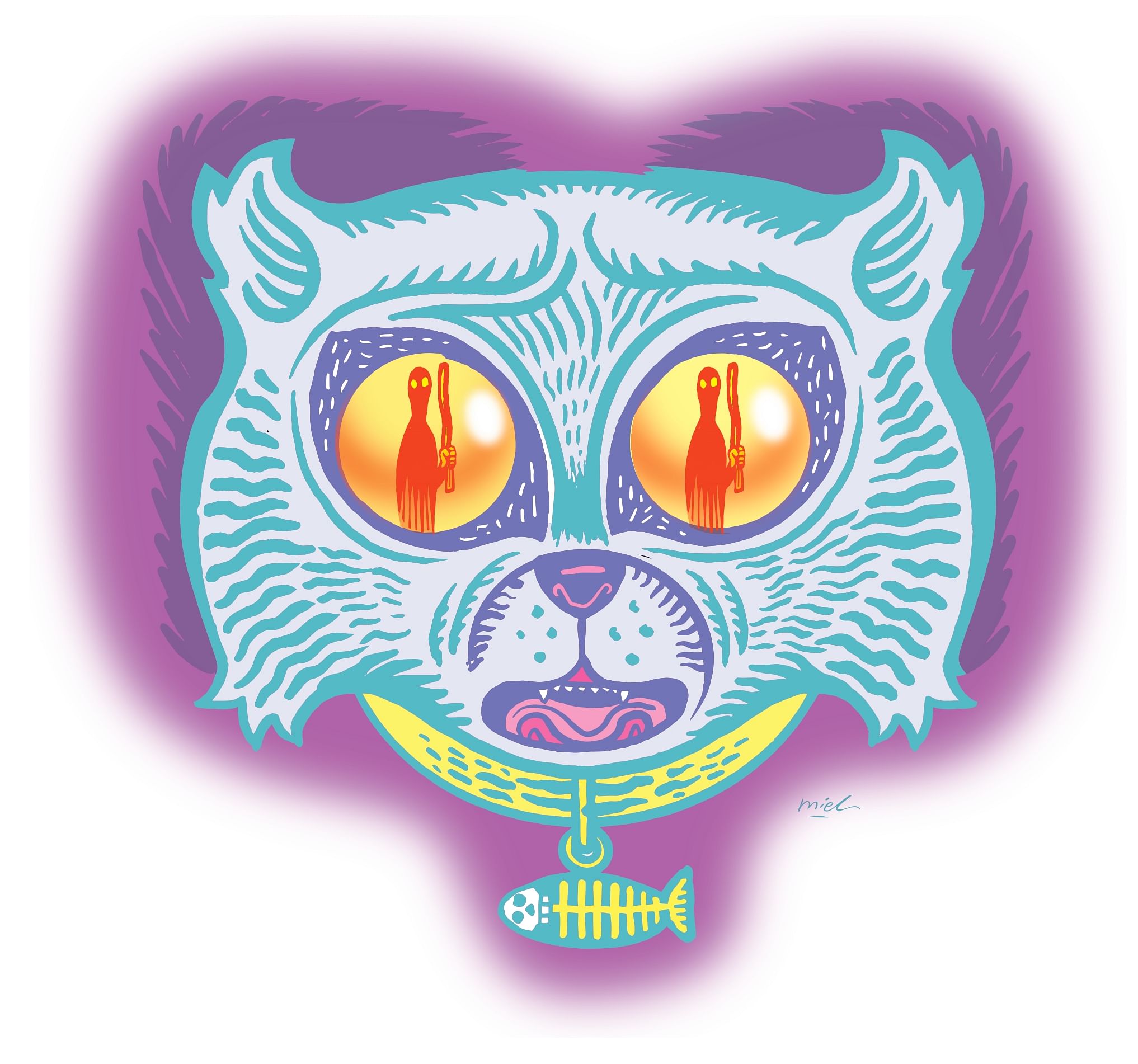
Chin Hui Shan
SINGAPORE - From amusement to displacement of anger, psychologists said that people abuse animals for a wide variety of reasons.
Promises Healthcare senior forensic psychologist June Fong told The Straits Times that some people abuse animals to relieve negative feelings like loneliness and frustration. Others do it as a form of retaliation, against the animal or its owner.
In December 2022, a cat died after a boy allegedly threw it off the 22nd storey of an Housing Board flat in Boon Lay.
Meanwhile, a teenage boy was arrested after a video showing him trying to perform obscene acts on a tabby cat in Bukit Panjang went viral.
The Society for Prevention of Cruelty to Animals (SPCA) told The Straits Times that 2023 has seen a “disproportionately high number” of cat abuse cases. It investigated 11 such cases from January to March. In comparison, it probed 16 cases in the whole of 2022 and 11 cases in 2021.
These instances of youth abusing animals could be due to boredom or a desire to seek thrills, but Ms Fong said that a history of domestic violence and childhood abuse could also play a part.
“If a child has witnessed someone else torturing an animal or hurting someone without consequence, they learn that it is not wrong to hurt another person or animal,” she said.
And while both a youth and an adult may experience similar urges of hurting an animal, Ms Fong said the youth tend to be more impulsive, being less capable of exerting the necessary self-control or mental reasoning to rein those urges in.
“Youths may also lack the ability to think about long-term consequences. They may see animals as an ‘easier’ target, especially so for stray animals, as the youth might think that nobody will notice if something happens to it,” she said.
Dr Annabelle Chow, clinical psychologist at Annabelle Psychology, said some young people may engage in sexual intercourse or sexual behaviour with animals out of curiosity or to seek affection, but there are other factors, such as intellectual impairment.
She also noted that there are links between being a victim or witness of sexual abuse in childhood and engaging in animal sexual abuse.
“Childhood victims who experience such adverse traumatic events are at higher risk of committing animal and sexual abuse in later life,” said Dr Chow.
Ms Lynn Tan, clinical psychologist at The Psychology Practice, said that among many reasons, individuals may also hurt animals to impress their friends or for entertainment.
She noted that while there are no local numbers that indicate that cats are more susceptible to abuse as compared with dogs, cats may remain targets of abuse owing to their smaller sizes, accessibility, and some of their behaviour traits, such as responses when being attacked.
The history and associations Singapore has towards cats, including their perceived “invulnerability” derived from the saying that cats have nine lives, beliefs about black cats and luck, or attitudes towards strays, may have contributed to them being targets, she added.
The correlation between animal abuse and domestic violence has been termed “The Link”. The website of the Animal Legal Defence Fund, an American animal advocacy organisation, cites several studies that have found a direct link between acts of cruelty to animals and violence toward people.
Among the studies cited are a landmark 1997 study by the Massachusetts Society for the Prevention of Cruelty to Animals and Northeastern University, which found that animal abusers are five times as likely to also harm other humans.
Another study, published 10 years ago, found that 43 per cent of those who commit school massacres also committed acts of cruelty to animals – generally against cats and dogs.
However, psychologists say that while animal abusers are likely to commit other violent behaviour, they may not necessarily grow up to be criminals.
Ms Fong said it is likely that animal cruelty is symptomatic of anti-social behaviour, which stems from underlying causes, including being exposed to familial or peer violence. This in turn makes abusers more prone to potentially engaging in violent or aggressive acts, she said.
Ms Tan said it does not mean animal abusers will grow up perpetuating violence, although such past behaviour is a risk factor.
“It goes back to understanding the motivators and the underlying reasons of why this person abused animals in the first place,” she said.
“With that, we probably have a more nuanced understanding of the level of risk a person might carry in adulthood.
At the same time, intervention is necessary, said Dr Chow. “To help correct such behaviour, it is important that we first understand the motivations (behind) such cruelty.”
While she is not aware of any direct evidence that animal abusers will go on to commit more serious crimes, there is a strong link between the severity of animal abuse and violence or aggression.
“Animal abusers who do not receive intervention are likely to continue engaging in these behaviours, with the severity and frequency possibly increasing over time,” she said, noting that the approach with youths to correct such behaviour is different.
“As parents and adults, we must approach our children’s acts of cruelty with kindness and compassion. Studies of animal abuse by children find that most mistreatment is unintentional, motivated by curiosity, and infrequent,” Dr Chow said.
Consistent public education on animal abuse is also a way to help prevent such behaviour, Ms Fong said, adding that mere punishment and shaming the abuser without giving them the tools to rehabilitate is futile.
Ms Fong said given how animal abuse is linked to human violence and criminality in general, animal abuse is not only an animal welfare problem but also a social problem.
“If left unaddressed, such acts might perpetuate the notion that animals are lesser beings and therefore, justified targets of aggression or even neglect,” she said.
In the same vein, Ms Tan said the prevalence of animal abuse is a threat to societal values.
“We need to speak about animal cruelty and have wider conversations on how our current systems affect prevailing attitudes towards groups that may be different from us. Are we doing justice in building an inclusive society that respects life equally?”
Call for more to be done to protect cats after ‘disproportionately high number’ of abuse cases in 2023

SINGAPORE - After Ms Umi Solikati found the mangled carcass of a black cat at the void deck of her Housing Board block in Boon Lay, she started patrolling the area for fear that more felines would be abused.
She had been feeding the cat named Panther every day for about 11 years, until it met its fate when a boy allegedly threw it off the 22nd storey of the block in December 2022.
On March 30, another cat was found dead – seemingly beaten to death – about 350m away from her block.
“I’m very afraid that more cats will be abused. Sometimes I walk around till past midnight looking out for the cats,” Ms Umi, 39, told The Straits Times.
“When I’m at home, if I hear something, such as a cat yowling like it’s in danger, I’ll quickly run outside to see what’s going on.”
These two instances of suspected animal cruelty are among several cases that have made headlines in recent months.
On April 11, a teenage boy was arrested after a video showing him trying to perform obscene acts on a tabby cat in Bukit Panjang went viral.
In February, the court heard the case of a 31-year-old man charged with abusing five cats in Ang Mo Kio, including throwing two down from HDB blocks and stomping on a cat’s neck.
‘Disproportionately high number’ of cat abuse cases in 2023
Society for the Prevention of Cruelty to Animals (SPCA) executive director Aarthi Sankar said the organisation has observed a “disproportionately high number” of cat abuse cases in 2023.
It investigated 11 such cases from January to March. In comparison, SPCA probed 16 cases for the whole of 2022 and 11 cases in 2021, she said.
Cat Welfare Society (CWS) president Thenuga Vijakumar said there has been a rise in numbers due to increased vigilance and caution, as well as reporting.
But she added: “I would rather there be over-reporting than under-reporting, because at least we have a fuller picture.”
She pointed out that CWS also consistently advocates for felines.
She said: “CWS has taken on the role of gathering information, educating and pushing for vigilance for such cases. We also do the grunt work, such as appealing for information and pursuing the matter with AVS (Animal and Veterinary Service) on a fortnightly basis.”

Cat rescuer Jenny Lim, 49, said social media has allowed people to shed light on abuse cases, and rescuers like herself are able to gather more accounts from witnesses.
One of the worst abuse cases she handled in 2022 involved a cat which had lacerations and open wounds, and parts of its skin had fallen off.
“The cat was in very poor condition, and we suspect it was starved by its fosterer. It weighed only about 1kg when we finally put it to sleep,” said Ms Lim, the founder of 2nd Chance Shelter.
“Some people hate cats and don’t care about them. But why vent their frustrations on innocent cats?”
Ms Jessica Kwok, group director of AVS, said it received an average of 1,250 reports of alleged animal cruelty and abuse each year from 2019 to 2022.
Of these, about 60 cases each year were related to animal cruelty.
Offenders were issued warning letters or composition fines, or prosecuted in court in egregious cases, she added.
CWS’ Ms Thenuga noted that some of the cases involved multiple cats, such as the high-profile case of a man who slashed 11 cats in Ang Mo Kio in 2021.
A seasoned cat rescuer, who wanted to be known only as Ms Wati, expressed frustration that more has not been done to protect the animals.
The 50-year-old education consultant, who has been rescuing animals for 10 years, added: “We’ve come to a point where there has to be real action – enough has been done to educate the public. These cases show that enforcement and deterrence are not effective enough.
“These perpetrators, they know what they are doing.”
Ms Thenuga echoed the sentiment, saying that while there might be more reporting of abuse, “what we’re not seeing is what happens after a report is made”.
This has led to frustration because there is “no clarity on what investigative steps (the authorities) are taking, and it is unclear if they are acting fast enough”, she said.
She said AVS should at least inform organisations like the SPCA and CWS about the progress of investigations, so they can provide assurance to the caregivers of the cats.
But Ms Kwok said AVS, which is part of the National Parks Board, takes all cases related to animal welfare seriously, and investigates all feedback.
“We will take appropriate enforcement action against anyone who does not provide adequate care for their pet or commits an act of animal cruelty,” she said.
Ms Kwok explained that investigations into cases of animal cruelty and poor animal welfare are often complex.
Among the challenges are a lack of eyewitnesses and direct evidence, and cases being reported late or not being reported at all.
Sometimes, carcasses had already been disposed of or were found to be in bad condition, “making post-mortem analyses impossible”, she added.

What can be done?
Those on the ground are calling for more to be done to educate the public.
Ms Thenuga said AVS could play a part in educating students in schools on caring for community animals and responsible pet ownership, or fund an animal welfare group to do so.
CWS is planning to launch a curriculum for schools in the second half of 2023 to fill this gap, but it will be up to individual schools to bring this to their students, she added.
“If we had funding, we could hire a full-time education executive to go to every school and run a programme, give assembly talks, or even mentor tertiary students for their projects.”
AVS said it has various platforms to raise awareness about animal welfare and responsible pet ownership.
These include Pets’ Day Out events, a webinar series, talks, roving exhibition panels and school plays.
Students can also go on a learning journey at AVS’ animal classroom with rescued animals at Jacob Ballas Children’s Garden to learn about keeping pets.
Meanwhile, SPCA has appealed to parents to do more.
“We urge parents and educators to underscore to their children the importance of treating all animals as sentient beings,” said Ms Sankar.
In October 2022, SPCA launched an ambassador programme for youth, which empowers them to raise awareness about animal abuse and cruelty.
Some cat caregivers are taking matters into their own hands.
A caregiver in her 50s, who wanted to be known only as Ms Joan, said she saw a group of children throwing stones at community cats in Tiong Bahru some years back.
At the time, her team of three caregivers stopped the children from doing so and explained that they should not mistreat community cats.
“We took pains to resolve the issue before it escalated. One of our caregivers even alerted the principal of their school,” she said.
“It seemed excessive then, but in hindsight, it was effective to nip the problem in the bud, especially with the recent incident of a minor throwing a cat over the parapet.”
On deterrence, Ms Sankar said that SPCA works closely with other animal welfare groups and the authorities to lobby for stiffer penalties that match the gravity of the abuse.
“These penalties will help deter potential abuse... Every instance of abuse and cruelty is a grave cause for concern,” she said.
“We share this world with other sentient beings, and it is our collective responsibility to treat them with dignity, compassion and respect.”
April 11, 2023
In the 56-second video, a boy is seen trying to perform obscene acts on the feline outside a HDB flat in Senja Road.
Despite the cat moving away, the boy is seen going after the animal, carrying it and continuing to carry out such acts against it. He also appears to grab the cat’s tail for at least six seconds afterwards.
March 30, 2023
The cat seemed to be beaten to death as there were bloodstains in the vicinity, said Cat Welfare Society’s senior community engagement manager Michelle Siau.
Blood had been smeared on the wall, letterbox and floor surrounding the cat, said the Society for the Prevention of Cruelty to Animals’ executive director Aarthi Sankar.
The Animal and Veterinary Service (AVS) is investigating the case.
Feb 1, 2023
He is accused of throwing two cats down from HDB blocks and stomping on the neck of one of them. Both cats died.
He is also accused of confining two cats in a small waterproof bag and slamming another cat twice against a wall.
He is out on bail of $5,000 and will return to court in May.
Dec 21, 2022
A day later, a video showing a boy allegedly throwing the cat off the 22nd storey of the block surfaced on social media.
The one-minute video showed a black cat walking out of a lift, followed by a young boy. Seconds later, he picks up the animal and, after looking around, throws the cat over the railing.
The Straits Times understands that the boy was not arrested or taken into custody.
AVS is investigating the case.
July 2021
Leow slashed 11 cats – some with a penknife – in Ang Mo Kio in April and May 2021. He was arrested in June 2021.
A psychiatrist from the Institute of Mental Health told the court that Leow’s acts of cruelty “were not borne from any difficulty in comprehending the consequences of his actions”.




:quality(70)/cloudfront-eu-central-1.images.arcpublishing.com/thenational/235UI3G2YU74CQAA7Y2TYBVJUU.jpg)
:quality(70)/cloudfront-eu-central-1.images.arcpublishing.com/thenational/CZI23X2ZGJQVUTSWGFP7TVRDQ4.jpg)
:quality(70)/cloudfront-eu-central-1.images.arcpublishing.com/thenational/5YWTXTAOHMFXMLL6MXRJGK34LQ.jpg)
:quality(70)/cloudfront-eu-central-1.images.arcpublishing.com/thenational/VKZY6XST3U55EWXQKKDSGTMY3M.jpg)
:quality(70)/d27020bajtkr6c.cloudfront.net/04-30-2023/t_1c891df8a1eb4aefa44c0b803d17637f_name_RC2AO0AJ66FM)




















